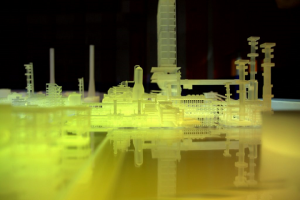So into this project from Chris Parker Tech:
In this project I built an interactive LED wall display using an Arduino and 3D printed parts.
See more on Chris Parker Tech, YouTube, GitHub, Thingiverse and Instructables.
Auto Added by WPeMatico
So into this project from Chris Parker Tech:
In this project I built an interactive LED wall display using an Arduino and 3D printed parts.
See more on Chris Parker Tech, YouTube, GitHub, Thingiverse and Instructables.

From diy chen on Hackster.io:
This is christmas gift diy ideas, a wireless charger with interactive lighting effects that can change the lighting according to the music to make your desktop more interesting. You can also add an acrylic shell to have more dazzling and colorful effects.
AH this project is so fun… but the video! The video got us pumped! From 8bitsandabyte on Hackster.io:
I’ve always wanted my drawings to come to life, so I made it happen using Processing, Adafruit’s Circuit Playground, an old LCD monitor and a snow globe.
The first step is transferring drawings from a piece of paper to the computer. I simply take a picture with my webcam.
Next, the drawing needs to be usable. With Processing, I analyse the image and turn all the pixels into either black or white. All the white pixels are made transparent, while all the black pixels remain. This turns the drawing into a usable digital version, like this cute little monster.
Read more and see more on YouTube
For visualization of prototypes and infrastructures, models are one of the key factors. A high quality model makes it possible to truly capture a virtual design, along with reducing the scale of the original to make it able to fit on a table, or even in the palm of your hand. Scale models can help designers gain a deeper understanding of all the elements that make up a structure or object, as well as how it works and if there are any flaws in its design.
But, as modern technologies like touchscreens, 3D printing, and video mapping continue to grow, models can now include newer, bolder elements that digitally transform them, making them easier to understand and visualize.
According to a translated quote in an article by TRSD, “It is no longer necessary to manually make all the elements that make up a model since with 3D printing and thanks to the digital models that are more common every day in any work (3D software, BIM models, etc.) we can reproduce in a simple way any element without resorting to complex manufacturing modes.”
For a long time now, traditional models have been meticulously created by hand, which means the model makers are truly closer to artists than simply manufacturers. But model making has continued to evolve over the years, thanks to these newer technologies, into what’s known as interactive models that users are able to…well, interact with more.
Interactive models, which simulate movement through the use of video projection or animations under transparent surfaces, have many advantages.
“They can be programmed with the desired animations or to reproduce real time processes,” I A Manufacturing wrote. “Use your AR/VR device to add movement to your model and a real-time simulation of the environment or the actions that you prefer. Display all the data that you desire in your models to increase your value.”
Models that incorporate these modern technologies are truly the future, and allow designers to expand the possibilities of model making. By adding augmented reality, which Foundry says is an overlay of content on the real world that’s not actually anchored to it, and virtual reality to models, companies like TRSD can give their clients a better understanding of what exactly their real projects will look like once completed. 3D printing gives incredible detail, and adding AR and VR make it possible to change or move objects around with simply the click of a button.
TRSD wrote, “Imagine for a moment that we can place our model on a touch screen that recognizes the elements that we are placing on it and that, depending on the type of object, the screen adapts the displayed image by changing everything around it, for example green areas, roads, services, etc.”
 Many product designers, construction and real estate companies, and architecture and engineering studios are already using interactive models to give their customers more bang for their buck. Another real world example of interactive models is IKEA, which provides an accessible app that allows customers to see how their new furniture will fit in their homes and offices.
Many product designers, construction and real estate companies, and architecture and engineering studios are already using interactive models to give their customers more bang for their buck. Another real world example of interactive models is IKEA, which provides an accessible app that allows customers to see how their new furniture will fit in their homes and offices.
Incorporating additional interactive technologies, such as touchscreens and video mapping, brings us even closer to a new class of interactive models that can be personally adapted to each individual user, which will allow for better communication between manufacturers and clients.
By incorporating technologies like AR, 3D printing, and VR, companies can create models and prototypes that are more interactive and realistic than ever before, while also lowering costs by using digital files and less material, which also helps in reducing waste.
What do you think of this story? Discuss interactive models and other 3D printing topics at 3DPrintBoard.com, or share your thoughts in the Facebook comments below.
[Images: TRSD]